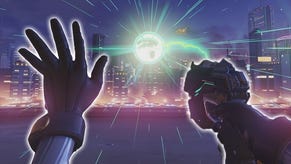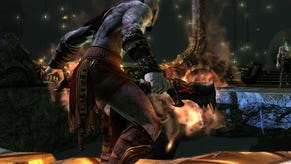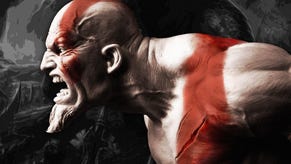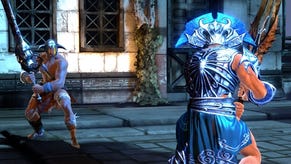God of War: Ascension preview: Kratos' combat evolved
Santa Monica switches up for the most radical change in God of War's combat yet.
God of War has never really had a problem with spectacle - this is a series with set-pieces that fling gods together with happy abandon, and one that toys with perspective and scale with dizzying ease and breathless pace. God of War's only real problem has been with the spectacles it's created itself - how can you trump battles that have consumed the heavens, and where do you go once you've felled Zeus?
The beginning of Ascension provides an answer of sorts to Sony Santa Monica's perennial problem. First it hits the rewind button, sending Kratos back to his time as a Spartan, but more importantly it's drilled down into all the tiny details that help make up the epic vision.
It's there in the spectacular visuals, which are now so embedded within the world of God of War it's becoming dangerously easy to be blasé about them (Digital Foundry's recent tech analysis should snap you out of that soon enough, though). Regardless, Ascension once again manages to look like a painting, even if it's most definitely the kind of painting you'd expect to find on the wall of a slightly troubled GCSE classics student.
It's there in the combat itself as well, although it's uncharacteristically coy in revealing itself. In place of the heady freedom and spectacle of past games, here Kratos is introduced bound in chains, held captive by Megaera, one of the furies. From this restriction, control's slowly dealt over to the player - first by a handful of QTE-fuelled dodges, and then further out still until the fiery blade swinging combat slowly clicks into place.
By the time that Kratos is fully under the player's command, it's apparent that this Ascension offers perhaps the biggest leap forward in combat mechanics that the series has taken to date. "After the first three, we just couldn't do all that again," says combat designer Jason McDonald, a longtime member of the God of War team immortalised by a trophy named in his honour in the HD remakes. "We had to change it up, and we did."
You'll feel it first in the fundamentals, such as the slightly springier blades, their subtly weaker attack attributed to the fact that this is a prequel that stars a less empowered Kratos. Beyond that, there's a broader set of systems that are new to God of War, and they're ones that help freshen up combat that, by the time of 2010's third instalment, was in serious danger of getting stale.
Countering the weaker blades is a new rage system, although it's elsewhere that the real changes have taken place. "One of the first ideas we had that Kratos was a Spartan warrior - he didn't have the chain blades until he picked them up from Aeres," explains McDonald. "Allowing him to pick weapons up in the world show that he's still a Spartan warrior, and he can pick up any weapon."
Those weapons, littered around the battle space or plucked from enemies' hands, replace the traditional unlocks of previous games. No longer will certain tools be doled out later in the game: they're now all available on the battlefield at any point, and as a result of that the combat's more varied, and a little broader to boot. Oddly enough for a new feature, it feels like something of a severance at first, but it doesn't supplant the XP and upgrading systems of previous God of Wars. That's now replaced by a set of elements that can be installed into Kratos' blades, and that can have XP piled into them.
"This time you can put elements into your blades, and those elements change your specials and where you put your super-moves," McDonald elaborates. "Your specials will be enhanced, your combos will be extended. There'll be things like fire plumes and electrical plumes that have different properties, and those properties will encourage you to switch up during play - so you might start off with a fire blade before switching up to a electrical blade."
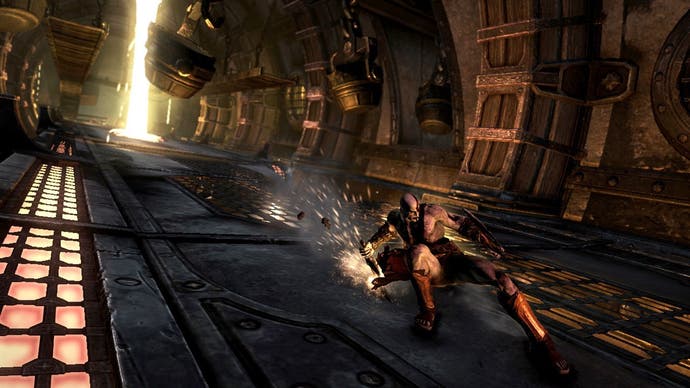
Kratos' basic move-set has been expanded, too. Now he's able to tether enemies with his chains, whipping them around like a wrecking ball. It's all a marked improvement on the slightly fudgy combat of previous God of War games, even if legacy issues such as Kratos' roll-dodge, with its painful pause before its execution, ensure that this is still a million miles away from the more intense scraps of Bayonetta and, more recently, Ninja Theory's DMC.
Not that Santa Monica mind so much. "Well, those games are a lot more hardcore than our game," admits McDonald. "Those games, if you ignore those systems you will lose and die. Our game has always been designed to be a little bit easier on the player - we want people to see the gorgeous visuals, and we want people to see the cool kill moves.
"I know we're going to get some flak from the hardcore crowd because it's not technical enough for them, but the result is something that more people can enjoy. But I will say that we're always striving to bring a little more strategy into the game, and I think we've moved that on in this game."
There's a different feel to Kratos, then, and it's a switch-up that's perhaps overdue. It's hard to escape the feeling that it's in the introduction of multiplayer that Ascension will truly distinguish itself from its predecessors, but it's just as hard not to be impressed by the scale of Santa Monica's vision, and the mountains it's moved to create another dizzy cascade of spectacle.



